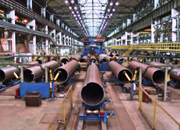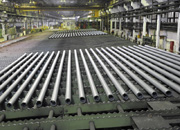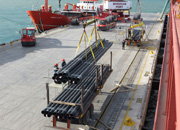Q690E hot-rolled seamless steel pipe is a high-strength, low-alloy structural steel material. Due to its excellent mechanical and weldability properties, it is widely used in heavy industries such as engineering machinery, coal mine hydraulic supports, shipbuilding, and bridge construction. As an upgraded product in the Q690 series steel, Q690E, through optimized composition design and manufacturing processes, significantly improves low-temperature impact toughness while maintaining high strength, making it one of the key basic materials in the current high-end equipment manufacturing field.
From a material properties perspective, the core advantages of Q690E hot-rolled seamless steel pipe are reflected in three aspects: First, its yield strength reaches over 690MPa, and its tensile strength can reach 770-940MPa, far exceeding that of ordinary Q355B and other conventional steels; second, by adding microalloying elements such as niobium, vanadium, and titanium and adopting a controlled rolling and cooling process, the material can still maintain an impact energy of over 27J at a low temperature of -40℃, meeting the stringent requirements for Grade E steel in the GB/T1591-2018 standard; third, the carbon equivalent (CEV) is controlled below 0.45%, and the Pcm value does not exceed 0.25%, giving the material a low sensitivity to cold cracking during welding. Actual application data from a construction machinery manufacturer shows that crane boom structures manufactured using Q690E hot-rolled seamless steel pipe can achieve a 15%-20% weight reduction under the same load conditions, while simultaneously increasing fatigue life by over 30%.
In terms of production technology, Q690E hot-rolled seamless steel pipes adopt a fully controlled rolling and cooling (TMCP) process: continuous casting of round billets → ring furnace heating → piercing → continuous rolling → sizing → cooling → straightening. Among these processes, rolling temperature control is particularly critical. The finishing rolling temperature must be strictly controlled within the range of 850±20℃, and accelerated cooling is immediately performed after final rolling, with a cooling rate maintained at 15-25℃/s. This refines the grain size and forms a microstructure dominated by bainite. Production practice at a steel plant in Shanxi Province shows that by adopting a two-stage rolling process (60%-70% deformation in the roughing stage and 30%-40% in the finishing stage), combined with an online heat treatment system, the fluctuation of the mechanical properties along the entire length of the steel pipe can be controlled within 5%, fully meeting the requirements for high-strength casing in the API 5CT standard.
In the welding process, Q690E hot-rolled seamless steel pipes require special attention to the optimization of process parameters. We recommend using a mixed gas shielded welding system of 80% Ar + 20% CO₂, with preheating temperature controlled within the range of 100-150℃ and interpass temperature not exceeding 200℃. Post-weld hydrogen removal treatment at 550-600℃ is required. A case study from a shipbuilding company shows that by using low-hydrogen welding electrodes CHE62CFLH (compliant with GB/T5117 standard) and strictly controlling the heat input within the range of 15-22 kJ/cm, the weld joint strength coefficient can reach above 0.9, and the heat-affected zone hardness is controlled below 350 HV10, fully meeting the CCS classification society's specifications for high-strength steel welded joints.
In terms of market applications, Q690E hot-rolled seamless steel pipes primarily serve three major sectors: In the construction machinery industry, some companies use them for key load-bearing components such as pump truck booms and excavator booms; in the energy equipment sector, this material is widely used in special working conditions such as high-pressure manifolds for coalbed methane development and high-pressure pipelines for shale gas fracturing trucks; and in marine engineering, due to its excellent seawater corrosion resistance (annual corrosion rate <0.1mm/a), it has become the preferred material for structures such as offshore wind turbine jackets and deep-sea drilling platform legs. According to statistics from the China Steel Structure Association, domestic consumption of Q690E grade steel pipes reached 850,000 tons in 2024 and is expected to exceed 1.2 million tons in 2026, with a compound annual growth rate of 18.7%.
Regarding quality control systems, leading manufacturers have generally established a full-process testing network from raw materials to finished products. Taking a listed company as an example, it uses a direct-reading spectrometer to analyze the composition of each heat of molten steel, and is equipped with an online ultrasonic flaw detector to achieve 100% non-destructive testing. Simultaneously, it uses equipment such as an electronic universal testing machine and a low-temperature impact testing machine to verify mechanical properties in batches. Of particular note is that for extra-thick-walled pipes with a wall thickness greater than 50mm, Z-axis performance testing is added, with a reduction of area requirement of ≥35% to prevent lamellar tearing. These stringent quality control measures have enabled domestically produced Q690E hot-rolled seamless steel pipes to successfully pass the EU CPR certification and the US API monogram certification, entering the international high-end market.
From the perspective of technological development trends, Q690E materials are evolving towards higher performance. Domestic research institutions have developed a new QP (Quenching and Partitioning) process for Q690E hot-rolled seamless steel pipes, increasing elongation to 22%-25% while maintaining the same strength, making it more suitable for complex forming processes. Some companies have also experimented with adding 0.001%-0.003% rare earth elements to the composition, increasing the impact energy at -60℃ by more than 40%. These innovations are expected to enable Q690E hot-rolled seamless steel pipes to play a greater role in extreme environment applications such as polar equipment and liquefied natural gas storage tanks.
Despite the significant advantages of Q690E hot-rolled seamless steel pipes, several key issues still need attention in practical applications: Abrupt changes in cross-section should be avoided during design; it is recommended that the transition fillet radius R ≥ 2 times the wall thickness. Flame cutting is prohibited during processing; plasma or laser cutting must be used. Proper moisture protection measures should be taken during storage, with relative humidity controlled below 60%. Only by fully understanding the material properties and strictly adhering to process specifications can the value of this high-performance steel be maximized. With the "14th Five-Year Plan" continuously increasing its support for the high-end equipment manufacturing industry, Q690E hot-rolled seamless steel pipe will inevitably play a more important role in the process of China's manufacturing industry leaping towards high-end.
 Threeway Steel is known as a professional supplier engaged in manufacturing and distributing a wide range of steel pipe, and our headquarter located the central part of China – Hunan and six associated factories throughout China.
Threeway Steel is known as a professional supplier engaged in manufacturing and distributing a wide range of steel pipe, and our headquarter located the central part of China – Hunan and six associated factories throughout China.
 Threeway Steel is known as a professional supplier engaged in designing, manufacturing and distribution of a wide range of steel products with the headquarter located the central part of China – Hunan and six associated factories throughout China.
Threeway Steel is known as a professional supplier engaged in designing, manufacturing and distribution of a wide range of steel products with the headquarter located the central part of China – Hunan and six associated factories throughout China.
 Threeway Steel is known as a professional supplier engaged in designing, manufacturing and distribution of a wide range of steel products with the headquarter located the central part of China – Hunan and six associated factories throughout China.
Threeway Steel is known as a professional supplier engaged in designing, manufacturing and distribution of a wide range of steel products with the headquarter located the central part of China – Hunan and six associated factories throughout China.
 Threeway Steel is known as a professional supplier engaged in designing, manufacturing and distribution of a wide range of steel products with the headquarter located the central part of China – Hunan and six associated factories throughout China.
Threeway Steel is known as a professional supplier engaged in designing, manufacturing and distribution of a wide range of steel products with the headquarter located the central part of China – Hunan and six associated factories throughout China.
 Threeway Steel is known as a professional supplier engaged in designing, manufacturing and distribution of a wide range of steel products with the headquarter located the central part of China – Hunan and six associated factories throughout China.
Threeway Steel is known as a professional supplier engaged in designing, manufacturing and distribution of a wide range of steel products with the headquarter located the central part of China – Hunan and six associated factories throughout China.

